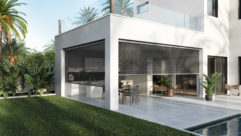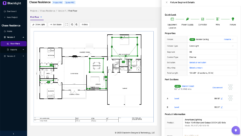Capitalizing On Custom Software
For New York City-based integrator Videosonic Systems, AV/IT convergence has not only changed the company’s working environment, but has also helped create a new approach to product development with results that are boosting its bottom line.
FOR NEW York City-based integrator Videosonic Systems, AV/IT convergence has not only changed the company’s working environment, but has also helped create a new approach to product development with results that are boosting its bottom line.
“We’re an AV company, and we’re producing software for our clients,” says Chief Technology Officer Dennis Flood. He says that one of the company’s most valuable and popular new product offerings in the past year or so hasn’t been an AV product or even a piece of hardware. Rather, it’s the Videosonic Information Display System, or VIDS, which is a software application that runs on ordinary Windows-based PCs.
“It’s an example of putting new tools and new features into the systems we deliver, and not delivering the same system twice,” Flood says.
He adds that VIDS has already proved to be a profit-maker for Videosonic, generating eight percent of the company’s annual revenues by itself, in addition to figuring critically in projects that account for a fifth of the firm’s income. Flood says that this revenue is truly incremental and represents a concrete gain of income that probably wouldn’t have been earned without the new product.
The genesis of VIDS is a familiar one. Like many other pro AV systems integrators and high-end AV dealers, Videosonic has been fighting the tide of commoditization, looking for ways to earn new revenue by offering creative and unique services rather than by selling hardware. Hardware margins, after all, are perennially shrinking, and dealers are always vulnerable to new competition.
But solving a client’s operating problems in creative ways can not only generate new revenue, but also solidify the integrator’s position among the client’s vendors.
Founded in 1981, Videosonic has specialized in museums and similar venues that feature multiple video displays. Among the company’s most prominent recent installs is the museum aboard the USS Intrepid, the World War II era aircraft carrier moored in the Hudson River on Manhattan’s West Side. In the Intrepid Sea-Air-Space museum, a VIDS server controls multiple video displays, audio, and other content in scheduled presentations that run all day, seven days a week (for more information on this project, see “More on www.proavmagazine.com”).
Installs such as the Intrepid’s, which demand flexible and user-friendly control systems and optimum use of a very restricted space, were the spurs that led Videosonic to develop VIDS. Typically, each separate video screen or audio playback was served by its own DVD player or other content source, Flood says. But systems with multiple combinations of players, screens, and speakers were often very difficult to control. “The simplest way to build one of these systems is with only one device, rather than with multiple devices,” he says.
Flood describes the VIDS system as “a show controller and a video controller rolled into one.” He says the product evolved as a way to pack maximum flexibility and content management capability into a system that was fundamentally simple and familiar to users.
VIDS will run on any PC running a Windows 2000 or more recent operating system, although it does require some additional video cards. The system can be programmed to generate up to 12 different video channels. “The same server that controls the video controls all of the screens,” Flood says. “We’ve turned an entire rack of equipment into a three-rack-space PC,” he adds, describing a computer roughly 5.25 inches high.
Capitalizing On Custom Software
For New York City-based integrator Videosonic Systems, AV/IT convergence has not only changed the company’s working environment, but has also helped create a new approach to product development with results that are boosting its bottom line.
Museums have proved to be particularly enthusiastic users of VIDS. “Museums often have single-channel displays, with video players local to each display,” Flood says. “That can be hard to manage. We’ve taken the IT model in designing a central control room for the entire museum, where users can control up to 12 different shows from the same server.”
By running common web server software on the PC, museum staff can connect through the facility’s network and use the browser interface to schedule and control its shows. VIDS and all of the devices it serves are connected in a network by common and inexpensive Cat5 cable, which can support nearly any kind of signal distribution, and also contributes to the future proofing of installations, Flood adds.
“VIDS will run without a hitch and with no maintenance for a long period of time,” he says. “It’s an easy sell once the client sees it in operation.”
Because each VIDS system is customized for an individual client, Videosonic isn’t marketing the system separately for purchase and re-use by others. Instead, it’s a new line item on the company’s job proposals, but one with significant long-term payoffs for the client.
Clients may opt to license VIDS for a longer term than just the initial show for which it was created. In that case, they become eligible for all software enhancements and updates that Videosonic implements. Flood adds that the basic system is also fairly easy to repurpose, making it possible for clients to re-use VIDS to drive video displays in new shows and exhibitions.
So far, VIDS has made some substantial contributions to Videosonic’s bottom line. While the software itself generated about eight percent of the company’s revenues last year, Flood says the impact of VIDS was more extensive than that. “About 20 percent of the revenue of the company last year came from projects that hinged on this product, that is, from jobs where the VIDS software was key to getting the project done,” he says.
The unique features VIDS offers have had other important financial benefits for Videosonic. “Once the client sees the system and what it can do, you’ll often get yourself specified as a sole source,” Flood adds, explaining that clients may create bid solicitation documents that require a combination of capabilities and features only available from VIDS.
In the short run, VIDS is available only from Videosonic, although Flood doesn’t expect that situation to last. “I do expect people to catch up,” he says. “But we’re also making what we do better for our customers.”
Still, Flood is confident that continuous upgrading of the VIDS software, coupled with customized responses to client needs should help the company maintain its edge. “We’ve never wanted to be a typical AV company selling hardware,” he says. “Hardware is always going to change, for example, in the move to high-definition video. But the design thinking behind these systems is the same. What we’re doing is taking a designer/consultant approach to the job rather than selling hardware.”
John McKeon is an independent consultant and writer based in the Washington D.C. area. He can be reached at [email protected].










